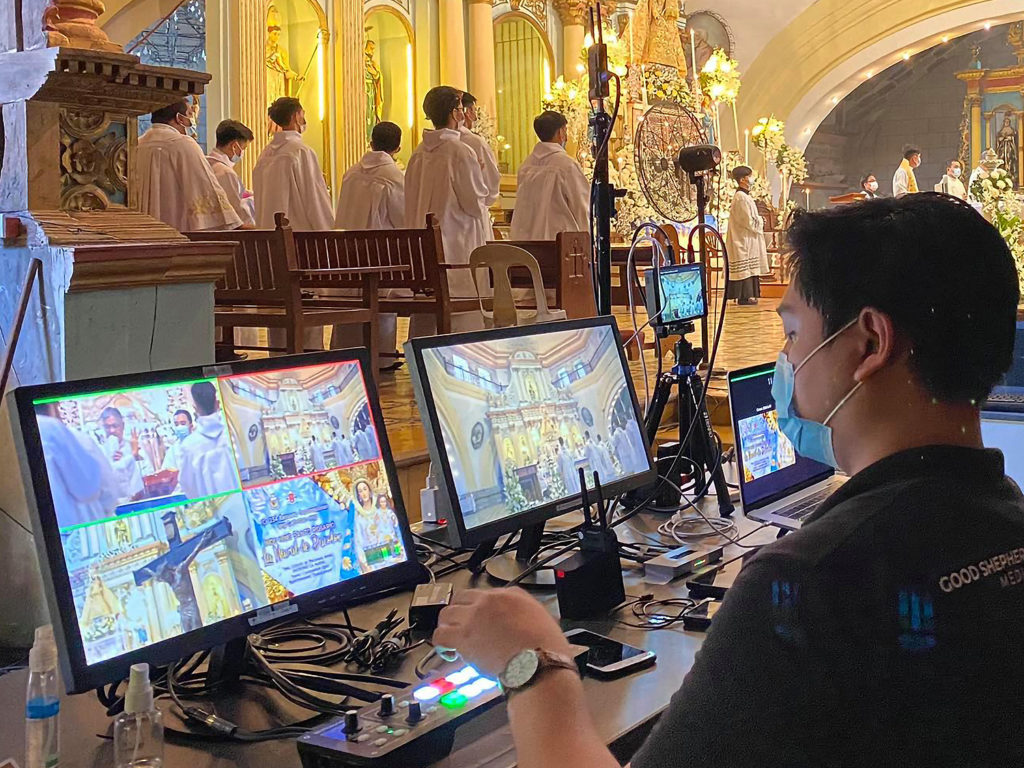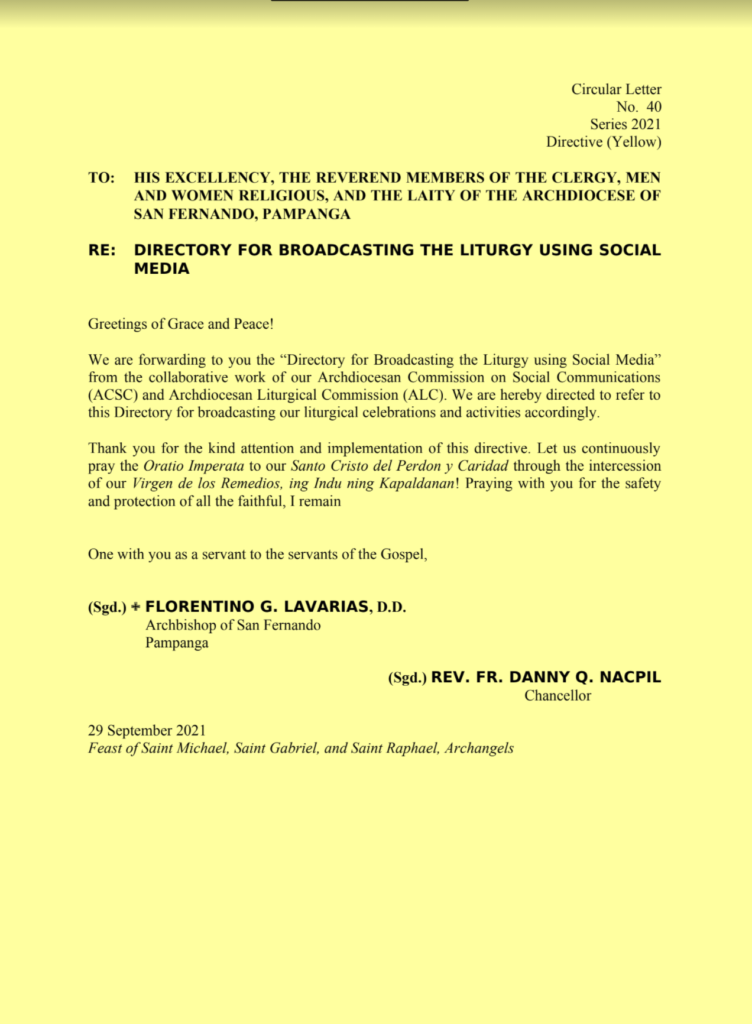
The Archdiocese of San Fernando has released instructions for broadcasting the liturgy through Social Media.
The directive, created by the Archdiocesan Commission on Social Communication, in collaboration with the Archdiocesan Liturgical Commission, is offered as a guide for priests, Catholic content creators, and communication & liturgy personnel entrusted with creating content and the live stream of liturgies.
In the circular letter released on September 29, Archbishop Florentino Lavarias asks the Archdiocese to implement these guidelines.
Read the guidelines below or download a copy from this link.
ARCHDIOCESE OF SAN FERNANDO
DIRECTORY FOR BROADCASTING THE LITURGY
USING SOCIAL MEDIA
A. CREATING SOCIAL MEDIA ACCOUNTS
1. Every parish should only have one official email address that will be used for all digital correspondences and accounts of the parish.
2. For all social media accounts, e.g., Facebook, Twitter, Instagram, YouTube, Tiktok, etc. the parish shall use the official email created.
3. Admin access as Administrator will only be given to the parish priest, parish secretary, a designated officer of the Parish Pastoral Council, and the head Media Ministry.
4. All parishes must only maintain one social media account per platform. Organizations/groups should merge their pages/channels to the official account of the parish.
5. The name of the page/channel shall follow the official name of the parish as registered in the Archdiocesan Archives or as approved by competent ecclesiastical authorities. This is to make sure that the faithful properly know the name and have easier access.
B. CREATING CONTENT
1. All produced content should be aligned to the Church’s teachings and must follow the Archdiocese’s codes of conduct, including but not limited to confidential information, verifiable consent, personal information, protection of a minor or a vulnerable person.
2. All produced content must be screened first. For the parish level, it must be approved first by the coordinator, then presented to the parish pastoral council and to the parish priest. For the archdiocesan content, it must be approved by the Director of the commission, then to the archbishop (if the content is of high importance).
3. Produced content must at least be always original; illegally downloaded and uploaded content from other pages or channels is to be strictly avoided. It is best to ask permission from the creator/composer who originally uploaded the content. Illegal use of any content will result in copyright sanctions i.e., muting of the video, taking down the content, legal notices, etc.
4. The creator/composer of any original content used should be credited/attributed by citing the name and tagging the page/owner. Terms such as “CTTO” (Credit To The Owner), “Credit to the Photographer” etc., should be avoided. Instead, the name of the person/group should be specifically cited and only permission is obtained from the person/group who owns the material.
5. For photo and video coverages, prior permission of the person to be photographed or filmed should be sought— especially if the photo or video is intended to be uploaded or used for promotional materials. As for minors, the prior permission of the parent or guardian should be obtained.
Printed Materials
1. Printed materials, especially those copyrighted, should not be photocopied or in any way reproduced without the prior permission of the author. Instead, the purchase of books, or the publisher’s reprints is highly encouraged. For prayers and other liturgical booklets, copies may be requested from the Archdiocesan Liturgical Commission.
Music
1. Printed music, even if it is a part of a liturgy, should not be copied or reproduced, unless prior permission is sought from and given by the composer.
2. Illegally downloading music from any website to use for the content or for broadcast without obtaining the permission of the composer or publisher, is prohibited. It is best to ask the music ministry to do a recording of the music that is intended to be used, then send it to the composer/publisher.
Photographs and Video
1. Illegal download/screenshot of a photograph or video and then upload to any media platform is not countenanced. Prior permission of the photographer, production should first be sought.
2. Showing a video/film for entertainment, either in its entirety or in clips, without a license, is also prohibited. Moreover, the compilation of multiple copyrighted clips to form one video is likewise not countenanced, unless prior permission for church use is obtained from the creators.
Online Videos
1. Creators of online videos automatically become the owner of the copyright, and only they have the right to give or deny permission to republish the video or use the video with or without royalties.
2. Prior permission of the video owner should be sought before any video is republished.
Content “Sharing”
1. Media ministers and parish officers should only share content that is relevant to the parish. From time to time, the account of the parish media ministry may also share content regarding public service advisory. This must be closely coordinated with the parish priest.
2. Media ministers and parish officers must avoid sharing content that reflects their own opinion, either on political or Church-related issues using the official accounts. Media managers must exercise prudence in carrying out the ministry. It is recommended that all posts must be reviewed by the parish priests prior to sharing.
3. Archdiocesan announcements should be made first on the pages/accounts of the Archdiocese, even if the announcements are related to the parish. On the other hand, announcements of the parish shall be made first of the official accounts and not on the personal pages or accounts of the priest, officers, or media ministers.
Responding to Online Messages
1. The social media accounts of the parishes are to be considered as an official mode of communication with the faithful. Parish secretaries, media ministers should be properly trained on how to respond to the messages.
2. Automated replies are encouraged for questions like requirements for sacraments, schedule of masses, etc.
C. BROADCASTING THE LITURGY
1. All broadcasts and other announcements of the parish shall be live streamed only at the official page/channel of the parish.
2. The seal of the parish may be placed on the upper right corner of the broadcast. There is no need for the Archdiocese of San Fernando’s seal unless the broadcast involves the Archbishop of San Fernando or an Archdiocesan event.
3. For Archdiocesan liturgical celebrations and events, parishes can request cross-posting with the ACSC. For broadcasts that include the Archbishop of San Fernando, the parish shall coordinate with the Archdiocesan Commission on Social Communication for cross-posting.
4. The Archdiocesan Commission on Social Communication is open to cross-posting parish-related activities for a wider audience reach.
5. The parish media ministry, if capable, may offer live-streaming services for sacraments and sacramentals, given proper approval from the parish priest or celebrant.
D. GUIDELINES FOR LIVE-STREAMING
1. It is important to note that the very nature of liturgy demands actual and physical celebration. But for serious pastoral reasons (i.e., sickness, in a place where it is impossible to attend mass physically, health restrictions due to the COVID-19 Pandemic, etc.), the Church has allowed broadcasting of the liturgy.
2. The eucharistic celebration is to be carried out following the directives of the General Instruction of the Roman Missal.
3. All online Masses should be registered with the Archdiocese where they could be monitored. In this way, the archbishop can either encourage more online Masses, or limit them if they are already too many, or if they are not in keeping with the liturgical standards and guidelines from this manual.
4. It is necessary that those assisting and serving in broadcasted liturgies should participate in the celebration fully, including the Media Ministers.
5. The liturgy must be broadcasted “live,” that is in real-time, as it is celebrated. In doing so, the viewer is able to join in the prayer of a worshiping community as the liturgy is celebrated. There should be no pre-recorded liturgies, not even pre-recorded readings proclaimed by “virtual” ministers.
6. Christ’s faithful are to hold the blessed Eucharist in the highest honor. To this end, we are encouraged to avoid any possible distractions. Chat rooms and running commentaries (prayer intentions, responses, and the like) as well as emoji reactions (❤️, 🙏, ) should be disabled while the Mass is going on.
7. For the convenience and disposition of the faithful, the schedule of broadcasted liturgies should be made available to them.
8. The use of “graphics” to aid the participation in the liturgy by flashing responses, readings, and songs must be maintained prudently. The overuse of animations, images, etc. that distract the solemnity of the celebration must be avoided.
9. Media ministers must give careful attention to the modes of Christ’s presence in the liturgy, e.g., the Word, the eucharistic bread and wine, the assembly, the priest (Sacrosanctum Concilium, #7).


2 thoughts on “ASF Releases Guidelines on Broadcasting the Liturgy”
Good afternoon. We at St. Sholastica’s Academy are holding Eucharistic celebration livestreamed via the school’s official facebook account. This ia participated physiamcally or face to face by few members of the community while the pupils and students who are not yet allowed to go to school for participate in the livestreamed Holy Mass. I have read in the directive that we need to seek permission from the Archdiocese. How shoukd we go about this? I am mrs chavez, the current institutional campus minister of the school. Thank you
Dear Ms. Chavez,
Thank you for your comment. Yes, please continue live streaming the Holy Mass for the scholastican community. For other questions, regarding broadcasts, communicaiton and the media, you may send our Archdiocesan Commission on Social Communication an email ([email protected]).
Thank you and God bless you, your family, and the community.